Key Insights
- Sia’s market cap grew 138% QoQ, ending the year at $373 million after reaching a $451 million quarterly high in mid-December.
- Used storage increased 25% QoQ, leading to storage utilization growth from 24% in Q3’23 to 29% in Q4’23, its highest level in 2023.
- Sia saw a 72% increase in active storage contracts, despite new contract issuance falling 20% QoQ. This dynamic points toward either longer contract terms or more activity toward the end of Q4.
- The distribution of blocks mined among Sia’s four mining pools became more decentralized throughout the year, with F2Pool’s market share dropping from 51% in Q4’22 to 30% in Q4’23.
- Sia released the official versions of its renting (renterd) and hosting (hostd) core software modules to simplify interactions with the network for storage providers and consumers.
Primer
Sia (SC) is a decentralized cloud storage network that combines a Proof-of-Work blockchain with a contract-based storage model. Storage contracts are used to uphold storage agreements between hosts and renters. Renters define the amount of data to be stored, the timeframe for storage, and the price. As users and storage providers enter into storage contracts, they each deposit the native asset — Siacoin (SC) — into an escrow account. Storage providers must cryptographically prove they are hosting the required data, and if they do not uphold the storage agreement, their collateral is slashed. At contract expiry, the storage provider receives the majority of the escrowed funds, with a small portion (3.9%) going to holders of Siafund (SF) tokens. Siafunds are security tokens that accrue SC to the SF holder from finished contracts on Sia.
Sia facilitates a global data storage marketplace by connecting storage providers (hosts) with underutilized hard drive capacity to storage consumers (renters). Siacoin can be used to pay for gas on the Sia blockchain and as the medium of exchange for the storage market. Renters pay a storage fee, upload/download bandwidth prices, and gas for the creation of storage contracts. Files stored on the Sia network are encrypted via ChaCha20 and stored redundantly via Reed–Soloman Erasure Coding. The encryption aspect ensures that uploaded files remain private, and redundancy ensures security by sharding files. Files uploaded to Sia are split into 30 chunks, or shards, and sent to various hosts. Only 10 shards are required to rebuild the file, and their copies are re-duplicated to new hosts whenever one is offline. For a full primer on Sia, refer to our Initiation of Coverage report.
Key Metrics
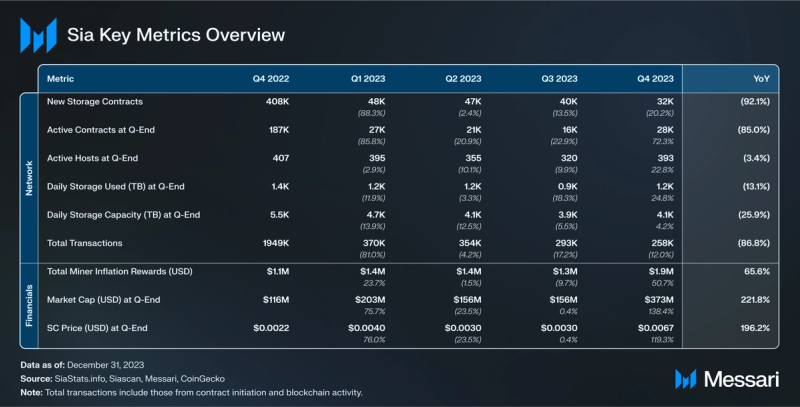
Performance Analysis
Active Contracts
When a contract is active, it means that the contract automatically facilitates the exchange between escrowed SC and storage provided by hosts.
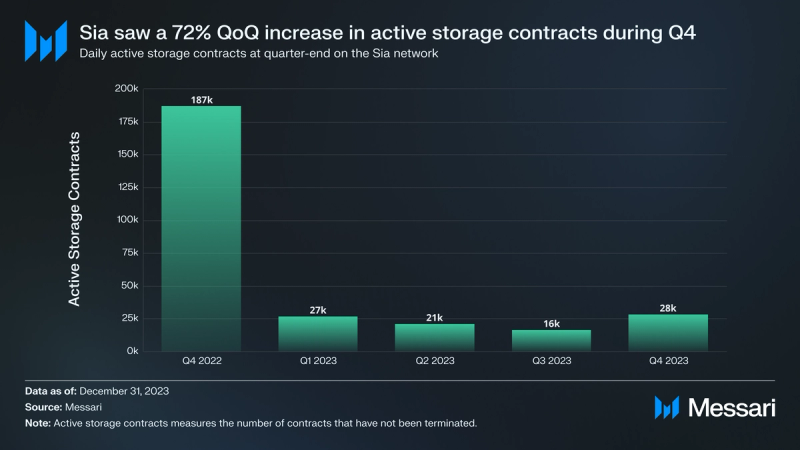
Sia active storage contracts grew in Q4, after declining for three consecutive quarters. The network saw a 72% QoQ increase in active contracts, despite falling 85% YoY. The beta version for Sia’s renting interface (renterd) was released in Q3, making the network easier to access for renters. The renting interface was fully released at the end of December, introducing an S3-compatible gateway that enables renters to use well-known tools like Duplicati (backup software). Both developments aim to make Sia more user-friendly than before. This release, combined with more optimistic market sentiment, may encourage future growth for Sia.
Transactions and New Contracts
Transactions on Sia account for all activity related to storage contracts, peer-to-peer transfers, and trades of the SC asset. New storage contracts are a measure of the origination of active storage contracts. New contracts require renters to allocate funds (called allowances) in advance that determine how much SC they are willing to pay for storage on Sia. The allowance is derived from an equation that multiplies the price in SC per TB stored by the expected number of TBs and by the expected number of months for storage. For example, if a user wanted to store 3 TB of data for 3 months at a price of 500 SC per TB, their allowance would be 4,500 SC (500 x 3 x 3). Renters also pay contract formation and upload bandwidth fees when creating new contracts. Hosts must also lock up collateral, which can be slashed if they don’t uphold the contract agreement.
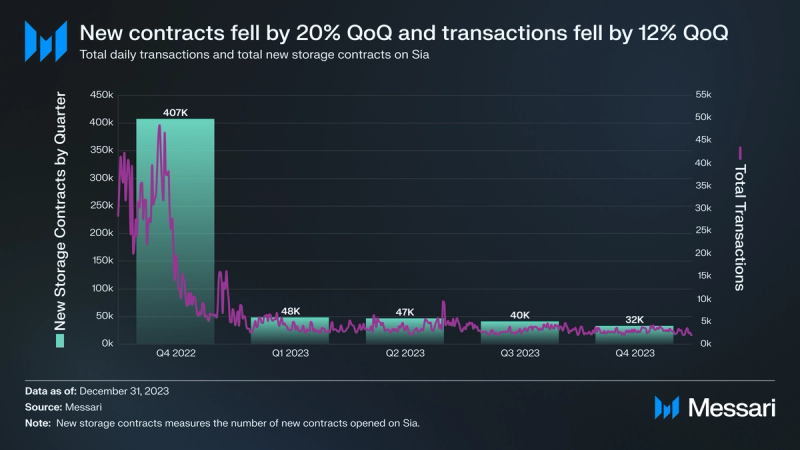
New contracts lead to various types of transactions on Sia, such as contract initiation payments, bandwidth payments, and ongoing storage payments. For this reason, transaction count tends to follow the initiation of new contracts. In Q4, new contract creations decreased by 20% QoQ, and transactions fell by 12% QoQ. A possible explanation for transactions falling less than new contracts may be the increase in active contracts, which maintain ongoing storage payments. Additionally, the increase in active contracts indicates that either more new contracts were initiated at the end of Q4 or that they were created with longer terms.
Storage Utilization
While the capacity of a storage network helps highlight its current scale, its utilization rate reveals the demand for the type of storage it optimizes for. Sia operates in the hot storage market, primarily targeting developers. It’s favored by those in search of a decentralized storage system offering both privacy and fast retrieval.
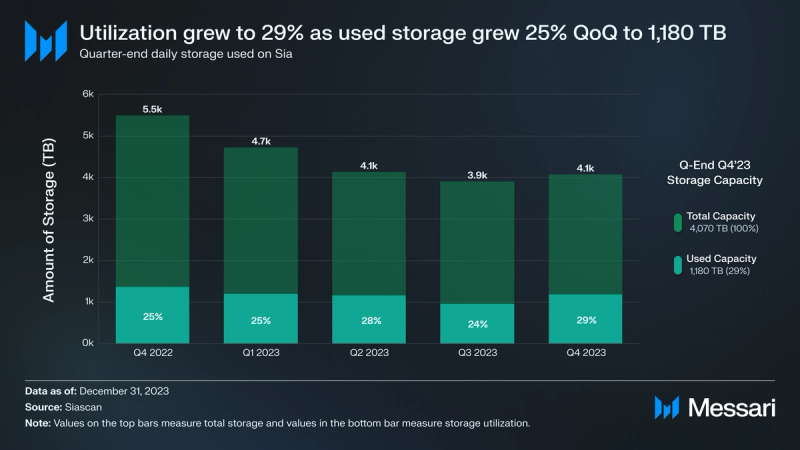
Sia uses a Stake-for-Access (SFA) token model to capture value and provide storage. In this model, utilized storage is achieved through storage contracts. Following a near-identical trajectory as active contracts, storage on Sia broke the pattern of decline from the previous three quarters, growing 25% QoQ. It’s expected that storage would follow active contracts, given that active contracts are agreements defining storage agreements. Sia’s Q4 storage utilization also hit its highest mark in a year, achieving 29% utilization.
Storage Prices
Renters entering a storage contract on Sia pay multiple fees to set up and maintain the contract. Storage fees are a product of the amount of data uploaded, the length of time of the contract, and the price in SC per TB per month.
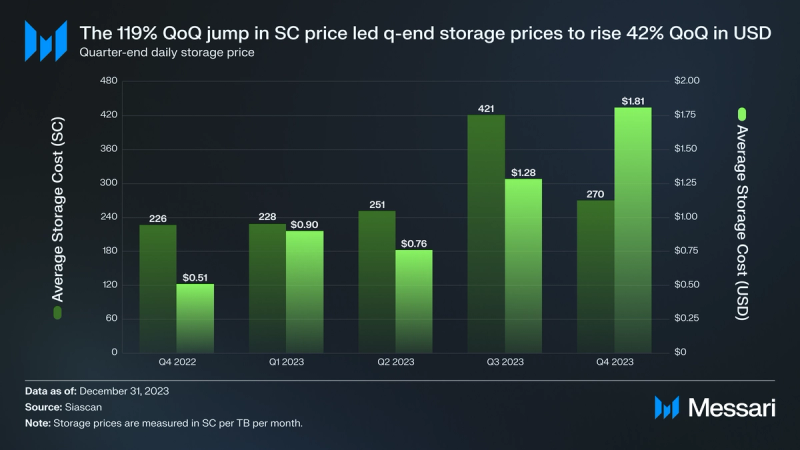
As Sia’s used storage grew 25% in Q4, the storage price denominated in SC fell by 36%. However, the storage price measured in USD grew by 42% QoQ, a result of the 119% jump in the SC price. While the dollar value of storage costs increased, it’s possible that storage utilization grew because renters could have already been holding SC. In this case, the 36% drop in storage price in SC would have made it cheaper to store data.
Bandwidth Costs
Storage providers offload the costs of uploading and downloading the renter’s data to the individual renter. Users seeking to store data on Sia initially pay upload fees to hosts, and users seeking to retrieve uploaded data pay download fees to hosts. In both cases, bandwidth is priced per TB.

Bandwidth costs denominated in SC moved in opposite directions during Q4: upload costs decreased by 25% QoQ, and download costs increased by 18% QoQ. Falling upload costs result in cheaper storage contracts for renters already holding SC. Hence, the increase in storage utilization may be a result of activity from renters already holding SC. For these renters, the fall in costs denominated in SC would make storage less expensive despite a rise in USD value.
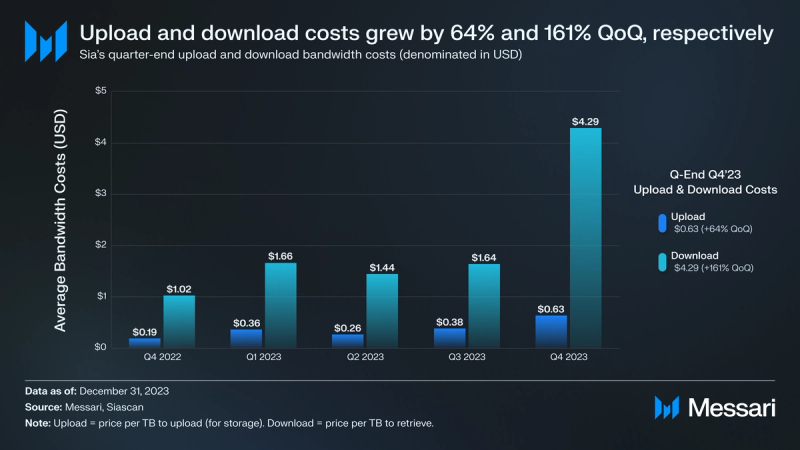
Upload and download bandwidth costs denominated in USD increased by 64% and 161%, respectively. This growth in the USD value of costs can be attributed to SC’s 119% QoQ price increase. Despite bandwidth prices and storage prices increasing in dollar terms, Sia still grew used storage by 25% QoQ, which may be indicative of renters already holding SC before the Q4 price jump.
Network Revenue
Sia produces revenue for multiple parties: hosts, miners, and Siafund (SF) holders. Its network revenue is the sum of payouts to hosts, Siafund fees, miner fees, and burned collateral. Burned collateral is included in revenue because burning SC makes it more scarce and theoretically accrues value to SC holders.

The QoQ increases in the USD value of storage costs (+42%), USD value of bandwidth costs (upload: +64% and download: +161%), and storage used (+25%) led to a 66% QoQ increase in Sia revenue. With the full releases of Sia’s hosting (hostd) and renting (renterd) interfaces deployed at the end of December, Sia is more accessible than before, which may lead to even more growth in the coming quarters.
Block Rewards in USD
Siacoin has an unlimited maximum supply; its current supply is over 51.5 billion SC. Siacoin inflates at 60,000 SC per block mined, with half going to miners and half to the Sia Foundation’s development fund (used for community grant funding). Because a portion of SC must be locked up in storage contracts, Siacoin’s inflation mechanism operates to maintain liquidity.

All Sia miners experienced QoQ increases in inflationary block rewards in USD. In Q4, DXPool and Luxor saw the most growth in rewards, increasing by 84% and 59%, respectively. Because rewards are proportional to work performed on the network, DXPool clearly outworked other miners, earning 53% more than the next-highest earning miner (F2Pool).
Percentage of Blocks Mined by Pool
The percentage of blocks mined by each mining pool shows how dominant certain entities are in block creation on Sia.
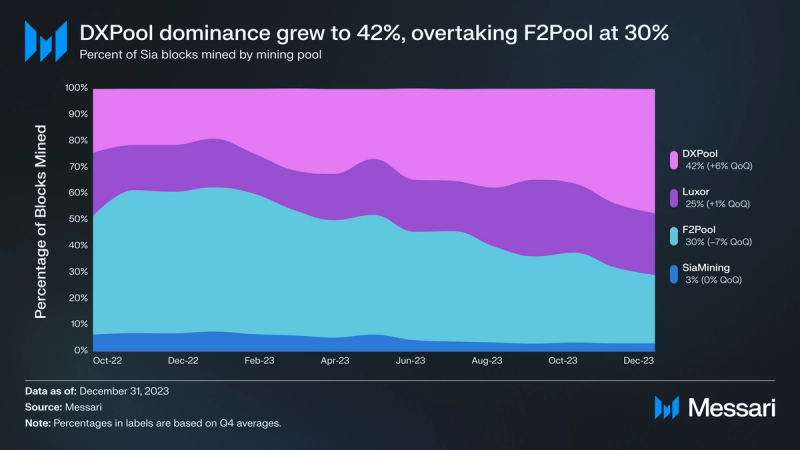
F2Pool has lost a significant market share in Sia mining throughout the year, falling from 51% market dominance in Q4’22 to 30% in Q4’23. Simultaneously, DXPool has taken a majority of this share, growing from 22% to 42% dominance throughout the year. Though DXPool (and Luxor) continue to grow market share, Sia’s mining share is more distributed than it was before, especially with no single mining pool accounting for more than 50%.
Market Cap
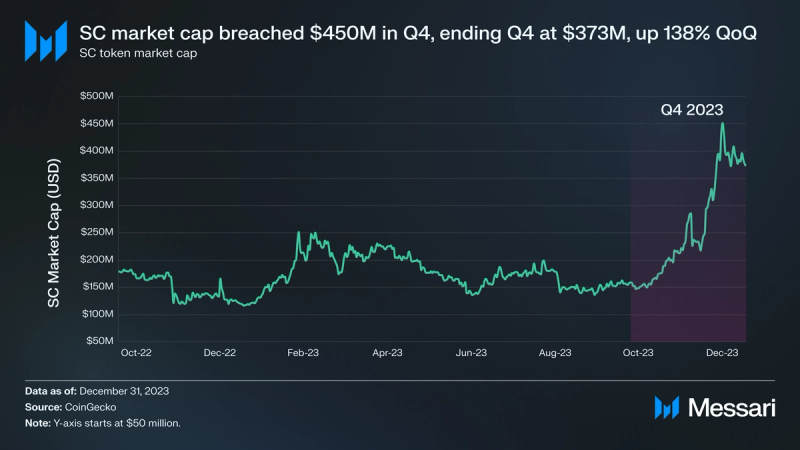
With the SC price increasing 119% QoQ and the supply inflating by 8.7% QoQ, Sia’s market cap grew by 138% during Q4, ending the year at $373 million. And in mid-December, it even spiked to $451 million. Despite the rise in SC price triggering increases in storage and bandwidth costs, storage used and storage utilization also increased. It’s possible that the growing market contributed to usage growth, attracting renters to Sia.
Qualitative Analysis
Ecosystem Grants
The Sia Foundation approved 14 grants that accounted for $436,000 in Q4 2023. Since its inception, the grant program has approved a total of ~$1.4 million for projects spanning from development to research. The grants committee meets biweekly and consists of six members: three employees of the Sia Foundation and three Sia community members. The 14 approved grants from Q4 are detailed below by order of grant size.
HTLC Upgrade – $100,000
The Sia Foundation approved $100,000 for Komodo Platform and Van Ketting to implement HTLC functionality into the Komodo DeFi Framework (DEX) protocol of Sia to enable atomic swaps. This proposal is based on a feasibility study (conducted by the same team) that sought to estimate the cost and development efforts of building atomic swaps via adaptor signatures. Upon completion of this grant, users should be able to use HTLC atomic swaps to trade SC in a peer-to-peer system via the Komodo Wallet DEX.
Proxmox Backup – $82,000
The Sia Foundation approved $82,000 for A-Z Computer Solutions to develop a cloud backup module for proxmox backup. It would take proxmox backup data and replicate it to Sia, potentially adding terabytes of data to the network. This proposal also followed a feasibility study conducted by A-Z Computer Solutions in Q3.
Proxmox backups refer to the backup solutions provided within the Proxmox Virtual Environment (PVE), a server virtualization environment. Proxmox allows administrators to take snapshots and back up virtual machines, containers, and the Proxmox host system. Doing so ensures data integrity and recovery in case of data loss, hardware failure, or other unforeseen issues.
Lume Web – $79,000
The Sia Foundation approved $79,000 for Hammer Technologies to continue building on Lume, a web application for accessing decentralized content. Lume Web will rely on Sia to act as the application’s decentralized storage network, with the goals of enabling data ownership, permissionless accessibility, and censorship resistance.
HostScore Benchmarking – $52,000
The Sia Foundation approved $52,000 for a community member named Michael Bulanov, developer of the previously funded Sia Satellite, to build a benchmarking tool. Once built, the tool will offer additional explorer-like functionality that Siascan does not. HostScore will primarily focus on host data in order to rate Sia hosts and make recommendations of certain hosts to renters based on their preferences for factors like performance, price, or geolocation.
SiaPeopleLearn – $25,000
The Sia Foundation approved $25,000 for Dapp Mentors to build an educational platform called SiaPeopleLearn. SiaPeopleLearn will simply be another iteration of the current Dapp Mentors Academy platform, except it will use Sia for decentralized storage purposes.
IPFSR – $23,000
The Sia Foundation approved $23,000 for a community member named Alvin Reyes to build an IPFS (InterPlanetary File System) gateway that will be able to store data on Sia. This gateway will configure a Light IPFS or IPFS node to use Sia’s renterd module as a backend. This approach will make it easy to use Sia with the performance and functionality benefits of using an IPFS gateway.
Sia Satellite II (Additional Scope) – $16,000
The Sia Foundation approved $16,000 for a community member named Michael Bulanov to add extra functionality to the already approved Sia Satellite project. Sia Satellite currently makes it easier for renters to use Sia by enabling fiat payments and abstracting many of the file management responsibilities to “satellites.” This additional scope adds functionality to Sia Satellite, which was added to Sia’s official renterd module. Such functionality includes S3 compatibility and upload packing, i.e., efficiently packaging and distributing data across a network.
Grafana Integration – $12,000
The Sia Foundation approved $12,000 for Bustedware LLC to develop a Grafana data source supporting the Sia hostd, renterd, and walletd software modules. This project aims to enable users to analyze the performance and utilization of the Sia ecosystem by integrating data sources with Grafana, a visualization platform.
Blockchain Gazette – $10,000
The Sia Foundation approved $10,000 for a community member named Stanford to make technical documentation for Sia in the form of online videos. Specifically, Stanford will produce a five-part animation series meant to educate users about the Sia network.
SkyMusic – $9,600
The Sia Foundation approved $9,600 for a community member named Mózes Dániel to build a music streaming platform. SkyMusic aims to be a decentralized alternative to Spotify that uses Sia for the platform’s storage needs. It will also enable users to upload their own music in addition to streaming music already hosted by the application.
Investment Tracker – $9,550
The Sia Foundation approved $9,550 for a community member named Shubham Palriwala to create an end-user application that allows users to view all their investments across multiple investment opportunities in a single place.
Mintyplex – $8,000
The Sia Foundation approved $8,000 for Mintyplex Technologies to build a digital commerce platform with an IPFS gateway using renterd storage as a backend. In addition to using Sia, Mintyplex will issue onchain certificates of authenticity in an attempt to maintain secure content distribution and monetization for creators.
SiaShare (Part 2) – $5,000
The Sia Foundation approved $5,000 for a community member named mjmay08 to add additional functionality and address community feedback on the already approved SiaShare project from Q2. SiaShare is a web service for encrypting, storing, and sharing files utilizing renterd.
Telegram Alert Bot – $5,000
The Sia Foundation approved $5,000 for a community member named Mert Köklü to build a Telegram bot for Sia users. This bot will forward alerts from the renterd and hostd modules to the Telegrams of participating users. This bot will be built using Docker as opposed to a centralized server, due to concerns related to security, privacy, and the technical limitations of a centralized approach.
Software Updates
Rent
Just before the year’s end, the Sia Foundation released an official version of renterd, an interface that enables Sia users to create storage contracts on the network. This V1 release marks the official shift of Sia’s move to its new core renting software. At the end of Q4, Sia also integrated renterd with Duplicati, an open-source software for backup purposes that supports data encryption, incremental backups, de-duplication, and other powerful features that help secure user data.
Host
The hostd module was also released with renterd in the final days of December. This module offers hosts a user-friendly interface, an API for managing storage resources and revenue, and an embedded web UI that enables remote management of storage operations.
Closing Summary
Sia had a productive Q4 experiencing QoQ growth in several key metrics, including used storage (+25%), active contracts (+72%), active hosts (23%), storage capacity (4%), SC price (+119%), and market cap (+138%). Despite a rise in the USD prices for storage and bandwidth costs, Sia ended Q4 with more data stored than in the previous quarter. And to end the year, it released the official versions of its renting (renterd) and hosting (hostd) interfaces — both of which make interacting with the network more seamless for renters and hosts. If the market continues in a bullish direction, Sia’s position as the longest-operating storage network in crypto may appeal to developers seeking to prioritize privacy and quick data retrieval.
——




















